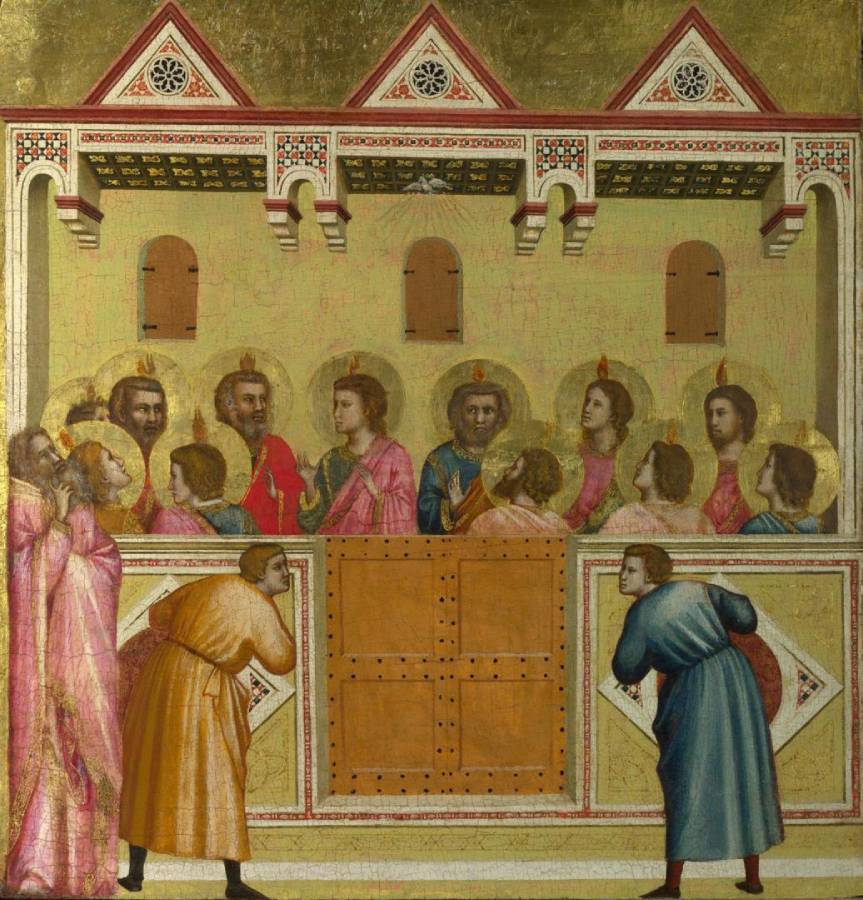Giotto (c.1267-1337) & Workshop
Pentecoste (Pentecost)
c.1310–1318
Egg tempera on poplar, 45.5 × 44 cm
National Gallery, London
The simplicity of the storytelling, the inclusion of lively details – like the old man who turns his head to better hear the commotion within – and the bulky solidity of the figures are characteristic of Giotto’s innovations in painting. His skill at bringing biblical stories to life, enabling viewers to identify with the humanity of the figures shown, was hugely influential and he is regarded as the founder of Italian Renaissance painting.
Christ’s followers were gathered together in Jerusalem to celebrate the Jewish Feast of Weeks, 50 days after Passover – which was also 50 days after the Crucifixion – when a strong wind began to blow and flames like ‘tongues of fire’ appeared on their heads. They were filled with the Holy Ghost and began to speak miraculously in a number of languages. Those around them were amazed and thought that they must be drunk. Soon a crowd of Jews visiting the city from Mesopotamia, Egypt and even Rome gathered to hear the disciples speaking about God in languages they could understand. Saint Peter reminded the crowd that this supernatural event had been predicted by the Old Testament prophet Joel who foretold that God would pour out his spirit upon his people. This moment is significant for Jesus’s followers after his death: it gave them the authority to continue preaching his message to all nations.
This picture demonstrates Giotto’s skill at telling a complicated story in a simple way, which he perfected in his frescoes telling the life of the Virgin Mary and Christ in the Arena Chapel in Padua. The compact, square shape of the panel means that the action takes place all at once, rather than as a sequence to be read from left to right. Giotto has used the house’s architecture to divide up the narrative events. A low wall, decorated with inlaid marble panels, separates the apostles from the crowd listening in. The symmetry of the arrangement of the figures focuses our attention into the centre of the image. Two young men on either side of the central gate turn their ears to listen, leaning in towards the centre of the image, where a white dove has appeared directly beneath the central gable. Radiating gilded rays, it represents the Holy Ghost.
Giotto depicted the tongues of fire as individual forked flames on the apostles‘ heads, painted over their gold haloes. Scientific examination has revealed that the rays from the dove were once much longer, reaching the apostles’ heads. Originally these were much more prominent as they were made of gilded tin that would have stood out above the painting’s surface.
This picture was the last in a sequence of seven images depicting the life and Passion of Christ, painted side by side on a long wooden panel. It was probably a dossal – an altarpiece that was placed in front of, rather than above, an altar. The other scenes are now held by museums in Europe and America. The Crucifixion scene shows Saint Francis with a man and a woman kneeling at the foot of the cross. It is likely that the patrons ordered the panel and chose the scenes, but we don’t know their identity or the original location of the altarpiece. Giotto worked throughout Italy and even in Avignon in France so it could have been ordered by patrons in a number of cities.
The high quality of the drawing in this panel suggests Giotto painted most of it, though he may have left the hands to his assistants. (NG)
